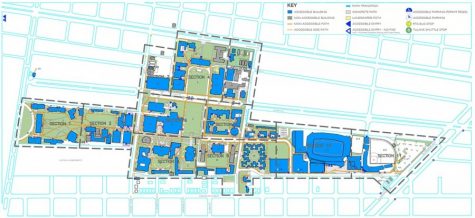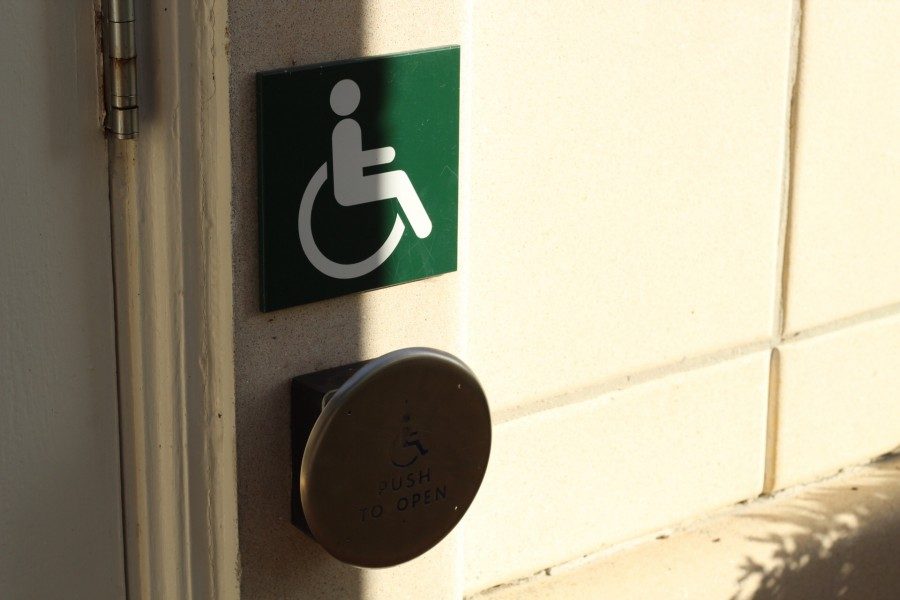Campus doorways provide wheelchair accessibility issues
Josh Jessimen | Photography Editor
One of many door-opening buttons that provide students with physical disabilities access to buildings across campus.
Tulane alumna Rebecca Lederkramer broke her arm and leg in a bike-riding accident during her senior year in Fall 2016. She lived off-campus in a three-story home and could not climb the stairs because of her injuries. So, Tulane moved her into a wheelchair-accessible dorm room in Willow Residences.
Though the dorm room was on the first floor, she still struggled getting around.
“There were no buttons on the door to open automatically,” Lederkramer said. “… [It] had to be opened manually which is hard to do in a wheelchair, especially for someone who has never spent any time in it before and doesn’t exactly know how to maneuver.”
The layout of the dorm made it difficult for her to reach her daily needs.
“There wasn’t enough room in between the toilet and the shower to have a wheelchair in the shower,” Lederkramer said. “It just wasn’t wheelchair accessible.”
Willow Townhomes surpasses other dorms in terms of wheelchair accessibility. For example, Josephine Louise Hall, Aron Residences, Irby Hall and Phelps Hall all lack wheelchair accessible entrances or elevators.

This resource on the Tulane website helps students with disabilities navigate campus.
Lederkramer was moved to Greenbaum Residence Hall, a newer dorm, for full wheelchair accessibility.
The Americans with Disabilities Act does not require old buildings to be retrofitted to meet the needs of disabled people. If building renovations reach a certain spending amount, however, they must make the entire building wheelchair-accessible. During Newcomb Hall’s renovations in 2010, elevators were installed to reach every floor. Currently, the renovations for Mussafer Hall will include a new elevator to increase wheelchair accessibility.
New buildings must be equipped with wheelchair-friendly components like ramps, elevators and automated doors. But, even with these additions, many users face challenges.
Patrick Randolph, director of the Goldman Center for Student Accessibility, reports a “whole litany of problems when it comes to doorways.” Many of the automated doors are operated with battery-powered buttons, not electricity. Sometimes the batteries die, making the doors inaccessible to people in wheelchairs.
“One time I went [to the tutoring center], and the button to get in was broken,” Lucy Ryan, president of Students and Advocates Supporting Strong Educational Diversity, said. “They didn’t know until I said anything.”
Ryan says physical obstruction is another issue with the buttons.
“The button to open the door to go out of the tutoring center was completely covered by a billboard sign type thing so you couldn’t push it,” she said. “You could technically reach back there if you weren’t in a wheelchair. And the door button to exit into the building instead of outside there was a trash can right in front.”
Randolph said he agrees with Ryan and also thinks some people who don’t have physical disabilities may not fully understand.
“For example … someone doesn’t have proper credentials and parks in a handicap parking space,” he said. “Some people aren’t mindful for those types of things.“
While Lederkramer had her friends open doors instead of using the buttons, she still faced difficulties entering and navigating some buildings. For example, Percival Stern Hall was difficult due to its single elevator for all wings, and she had trouble entering Joseph Merrick Jones Hall because of its steep ramp.
To try to remedy these problems, the Goldman Center partnered with the Tulane University Police Department and Facilities Services to test the buttons on their daily rounds to make sure they function. They plan to embark on a large-scale project to assess and update accessibility tools.
“They (Facilities Services) look at the buildings and determine a hierarchical system of demands of what buildings would be best suited for fitting these types of buildings quicker also trying to have a plan in place for adding new devices,” Randolph said. “So things that we’ve taken the time to make them accessible … remain accessible.”
Your donation will support the student journalists of Tulane University. Your contribution will allow us to purchase equipment and cover our annual website hosting costs.

















Leave a Comment